Physical Address
304 North Cardinal St.
Dorchester Center, MA 02124
The nervous system, with its central and peripheral divisions, maintains and controls all body functions by its voluntary and autonomic responses. The evaluation of motor, sensory, autonomic, cognitive, and behavioral elements makes neurologic assessment one of the most complex portions of the physical examination. This chapter focuses on assessment of the cranial nerves, cerebellar function and proprioception, sensory function, and the superficial and deep tendon reflexes. Assessment of mental status (cognitive function, communication, and behavior) is addressed in Chapter 7 . Muscle strength assessment is addressed in Chapter 22 .
Test cranial nerves I through XII.
Evaluate coordination and fine motor skills by:
Rapid rhythmic alternating movements
Accuracy of upper and lower extremity movements
Evaluate balance using the Romberg test.
Observe the patient’s gait for:
Posture
Rhythm and sequence of stride and arm movements
Test primary sensory responses to:
Superficial touch
Superficial pain
Test cortical sensory response to:
Vibration with a tuning fork over joints or bony prominences on upper and lower extremities
Position sense with movement of the great toes or a finger on each hand
Identification of familiar object by touch and manipulation
Two-point discrimination
Identification of letter or number “drawn” on palm of hand
Identification of body area when touched
Assess superficial and deep tendon reflexes
Plantar reflex
Abdominal reflexes
Cremasteric reflex in male patients
Biceps, brachioradialis, triceps, patellar, and Achilles deep tendon reflexes
Ankle clonus
The central nervous system (CNS) (brain and spinal cord) is the main network of coordination and control for the body. The peripheral nervous system, comprising the cranial and spinal nerves and the ascending and descending pathways, carries information to and from the CNS. The autonomic nervous system coordinates and regulates the internal organs of the body, such as cardiac muscle and smooth muscle. It has two divisions, each tending to balance the impulses of the other. The sympathetic division prods the body into action during times of physiologic and psychologic stress; the parasympathetic division functions in a complementary and a counterbalancing manner to conserve body resources and maintain day-to-day body functions such as digestion and elimination.
The intricate interrelationship of the nervous system divisions permits the body to perform the following:
Receive sensory stimuli from the environment
Identify and integrate the adaptive processes needed to maintain body functions
Orchestrate body function changes required for adaptation and survival
Integrate the rapid responsiveness of the CNS with the more gradual responsiveness of the endocrine system
Control cognitive and voluntary behavioral processes (see Chapter 7 )
Control subconscious and involuntary body functions
The brain and spinal cord are protected by the skull and vertebrae, the meninges, and the cerebrospinal fluid (CSF). Three layers of meninges surround the brain and spinal cord, assisting in the production and drainage of CSF ( Fig. 23.1 ). CSF circulates between an interconnecting system of ventricles in the brain and around the brain and spinal cord, serving as a shock absorber.
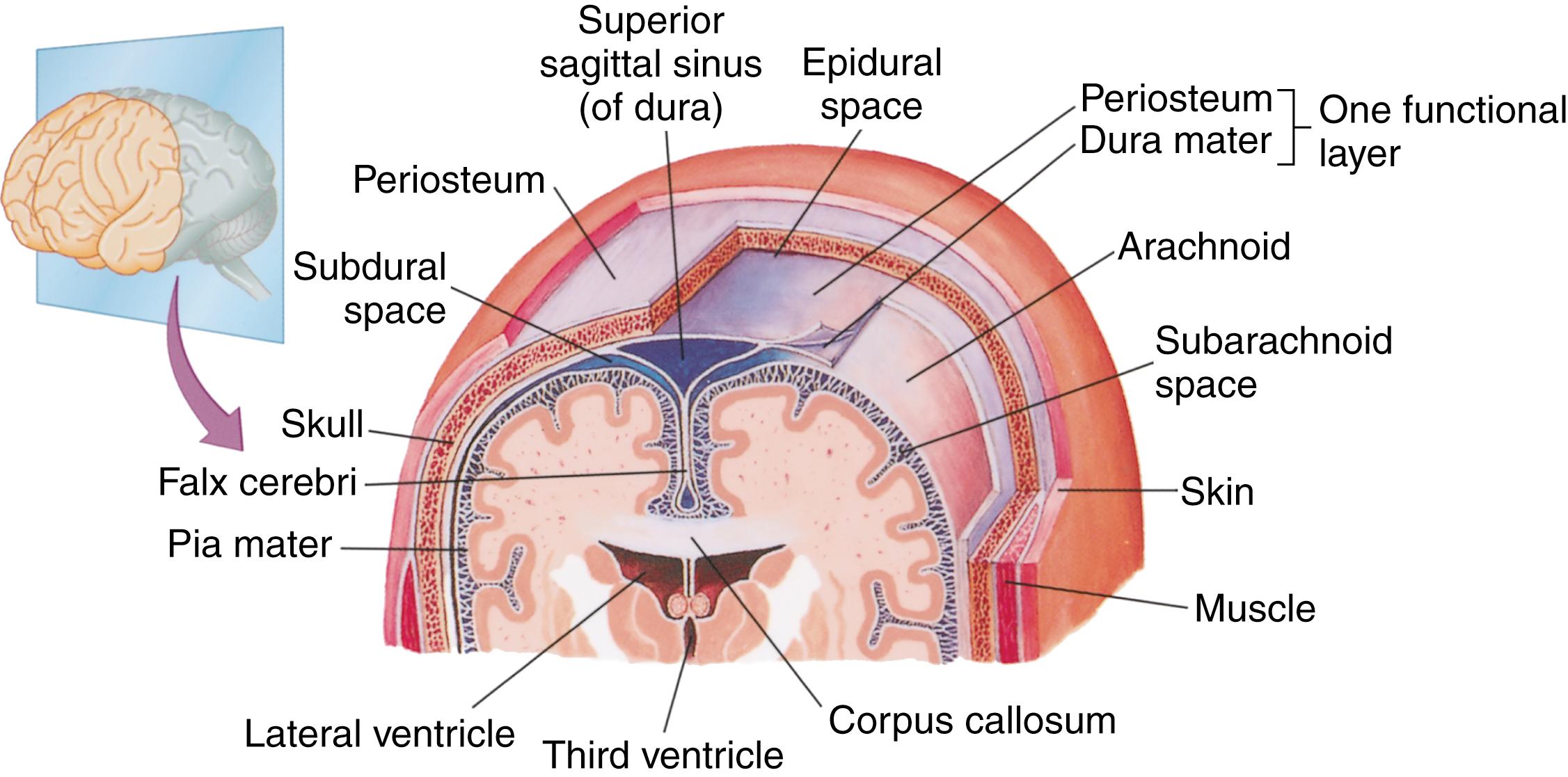
The brain receives its blood supply (approximately 20% of the total cardiac output) from the two internal carotid arteries and two vertebral arteries ( Fig. 23.2 ). Blood drains from the brain through venous plexuses and dural sinuses that empty into the internal jugular veins. The three major units of the brain are the cerebrum, the cerebellum, and the brainstem.
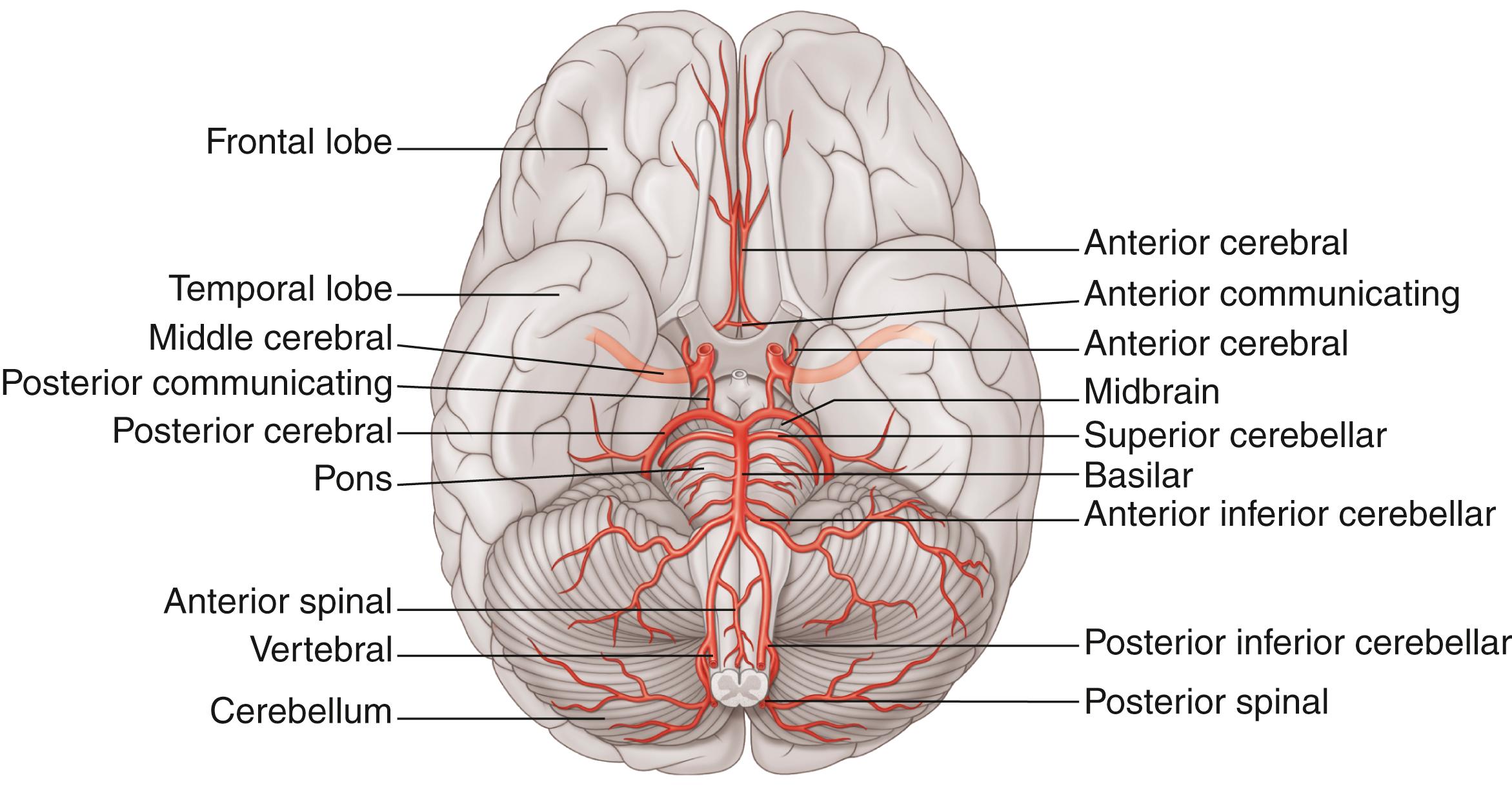
Two cerebral hemispheres (right and left), each divided into lobes, form the cerebrum. The gray outer layer, the cerebral cortex, houses the higher mental functions and is responsible for general movement, visceral functions, perception, behavior, and the integration of these functions. The hemispheres control the contralateral (opposite) side of the body. Commissural fibers (corpus callosum) interconnect the counterpart areas in each hemisphere, permitting the coordination of activities between the hemispheres ( Fig. 23.3 ; see also Fig. 7.1 ). The frontal lobe contains the motor cortex associated with voluntary skeletal movement and fine repetitive motor movements, as well as the control of eye movements. Specific areas in the primary motor area are associated with the movement of specific parts of the body. The corticospinal tracts extend from the primary motor area into the spinal cord.
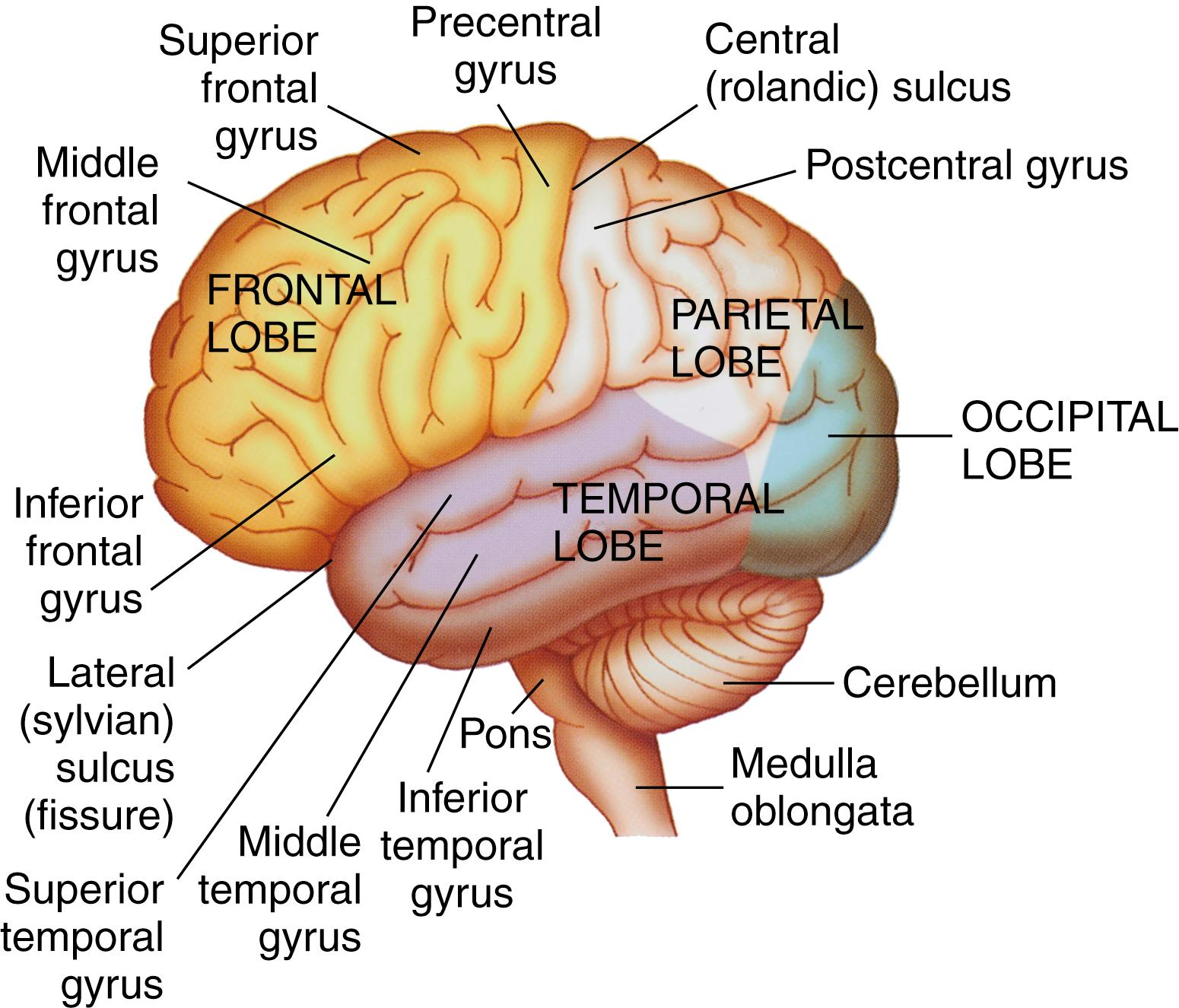
The parietal lobe is primarily responsible for processing sensory data as it is received. It assists with the interpretation of tactile sensations (i.e., temperature, pressure, pain, size, shape, texture, and two-point discrimination), as well as vision, taste, smell, and hearing. Recognition of body parts and awareness of body position (proprioception) are dependent on the parietal lobe. Association fibers provide communication between the sensory and motor areas of the brain.
The occipital lobe contains the primary vision center and provides interpretation of visual data.
The temporal lobe is responsible for the perception and interpretation of sounds and determination of their source. It is also involved in the integration of taste, smell, and balance. The reception and interpretation of speech is located in the Wernicke area. The medial temporal lobes include the hippocampi, which are essential for memory storage.
The basal ganglia system functions as the extrapyramidal pathway and processing station between the cerebral motor cortex and the upper brainstem. Through its interconnections with the thalamus, motor cortex, reticular formation, and spinal cord, the basal ganglia refine motor movements.
The cerebellum aids the motor cortex of the cerebrum in the integration of voluntary movement. It processes sensory information from the eyes, ears, touch receptors, and musculoskeletal system. In concert with the vestibular system, the cerebellum uses the sensory data for reflexive control of muscle tone, balance, and posture to produce steady and precise movements. The cerebellum’s hemispheres have ipsilateral (same side) control of the body.
The brainstem is the pathway between the cerebral cortex and the spinal cord, and it controls many involuntary functions ( Table 23.1 ). Its structures include the medulla oblongata, pons, midbrain, and diencephalon. The nuclei of the 12 cranial nerves arise from these structures. The thalamus is the major integrating center for perception and interpretation of sensations such as pain and temperature. The thalamus also relays sensory aspects of motor information between the basal ganglia and cerebellum. The pons transmits information between the brainstem and the cerebellum, where motor information from the cerebral cortex is relayed to the contralateral cerebellar hemisphere. The medulla oblongata is the site where the descending corticospinal tracts decussate (cross to the contralateral side).
| Structure | Function |
|---|---|
| Medulla oblongata CN IX–XII |
Respiratory, circulatory, and vasomotor activities; houses respiratory center Reflexes of swallowing, coughing, vomiting, sneezing, and hiccupping Relay center for major ascending and descending spinal tracts that decussate at the pyramid |
| Pons CN V–VIII |
Reflexes of pupillary action and eye movement Regulates respiration; houses a portion of the respiratory center Controls voluntary muscle action with corticospinal tract pathway |
| Midbrain CN III and IV |
Reflex center for eye and head movement Auditory relay pathway Corticospinal tract pathway |
| Diencephalon CN I and II Thalamus |
Relays impulses between cerebrum, cerebellum, pons, and medulla (see Fig. 23.4 ) Conveys all sensory impulses (except olfaction) to and from cerebrum before their distribution to appropriate associative sensory areas Integrates impulses between motor cortex and cerebrum, influencing voluntary movements and motor response Controls state of consciousness, conscious perceptions of sensations, and abstract feelings Interconnected with limbic system to help manage emotions and memories |
| Epithalamus | Houses the pineal body that secretes melatonin and controls the sleep-wake cycle Connects limbic system to other parts of the brain |
| Hypothalamus and pituitary gland | Interconnects endocrine and neurologic systems to maintain temperature, water metabolism, body fluid osmolarity, feeding behavior, and neuroendocrine activity Secretes hormones for control of growth, lactation, vasoconstriction, immune response, and metabolism |
Cranial nerves are peripheral nerves that arise from the brain rather than the spinal cord. Each nerve has motor or sensory functions, and four cranial nerves have parasympathetic functions ( Table 23.2 ).
| Cranial Nerves | Function |
|---|---|
| Olfactory (I) | Sensory: smell reception and interpretation |
| Optic (II) | Sensory: visual acuity and visual fields |
| Oculomotor (III) | Motor: raise eyelids, most extraocular movements Parasympathetic: pupillary constriction, change lens shape |
| Trochlear (IV) | Motor: downward, inward eye movement |
| Trigeminal (V) | Motor: jaw opening and clenching, chewing, and mastication Sensory: sensation to cornea, iris, lacrimal glands, conjunctiva, eyelids, forehead, nose, nasal and mouth mucosa, teeth, tongue, ear, facial skin |
| Abducens (VI) | Motor: lateral eye movement |
| Facial (VII) | Motor: movement of facial expression muscles except jaw, close eyelids, labial speech sounds (b, m, w, and rounded vowels) Sensory: taste—anterior two-thirds of tongue, sensation to pharynx Parasympathetic: secretion of saliva and tears |
| Acoustic (VIII) | Sensory: hearing and equilibrium |
| Glossopharyngeal (IX) | Motor: voluntary muscles for swallowing and phonation (guttural speech sounds) Sensory: sensation of nasopharynx, gag reflex, taste—posterior one-third of tongue Parasympathetic: secretion of salivary glands, carotid reflex |
| Vagus (X) | Sensory: sensation behind ear and part of external ear canal Parasympathetic: secretion of digestive enzymes; peristalsis; carotid reflex; involuntary action of heart, lungs, and digestive tract |
| Spinal accessory (XI) | Motor: turn head, shrug shoulders, some actions for phonation |
| Hypoglossal (XII) | Motor: tongue movement for speech sound articulation (l, t, d, n) and swallowing |
The 40 to 50 cm long spinal cord begins at the foramen magnum as a continuation of the medulla oblongata and terminates at L1 or L2 of the vertebral column. Fibers, grouped into tracts, run through the spinal cord carrying sensory, motor, and autonomic impulses between higher centers in the brain and the body. The gray matter, arranged in a butterfly shape with anterior and posterior horns, contains the nerve cell bodies associated with sensory pathways and the autonomic nervous system. The white matter of the spinal cord contains the ascending and descending spinal tracts ( Fig. 23.4 ).
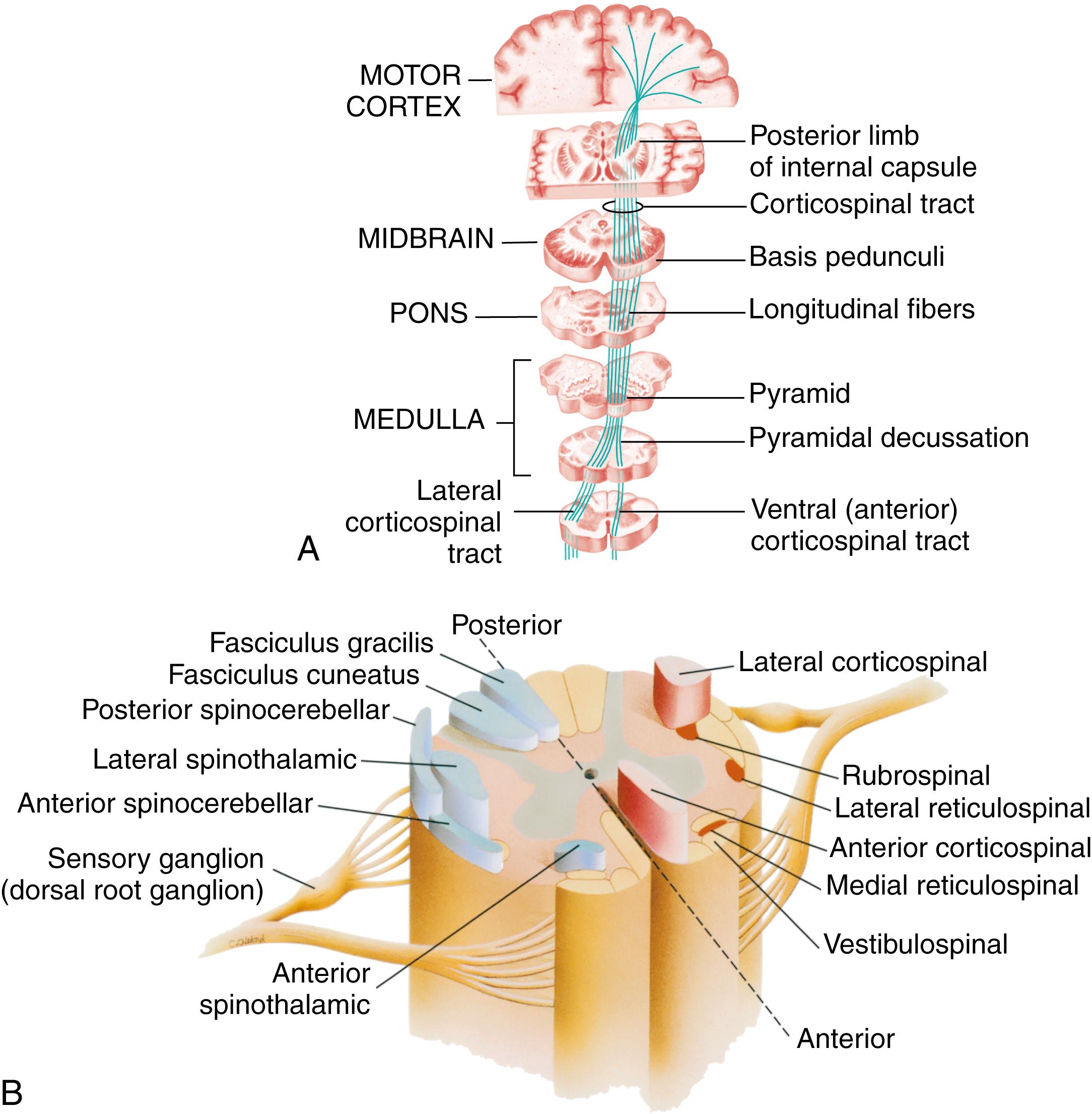
The ascending spinal tracts (e.g., spinothalamic, spinocerebellar) mediate various sensations. These spinal tracts manage the sensory signals necessary to perform complex discrimination tasks. They are capable of transmitting precise information about the type of stimulus and its location. The posterior (dorsal) column spinal tract (fasciculus gracilis and fasciculus cuneatus) carries the fibers for the sensations of fine touch, two-point discrimination, and proprioception. The spinothalamic tracts carry the fibers for the sensations of light and crude touch, pressure, temperature, and pain.
The descending spinal tracts (corticospinal, reticulospinal, vestibulospinal) convey impulses from the brain to various muscle groups by inhibiting or exciting spinal activity. They also have a role in the control of muscle tone, posture, and precise motor movements. The corticospinal (pyramidal) tract permits skilled, delicate, and purposeful movements. The vestibulospinal tract causes the extensor muscles of the body to suddenly contract when a person starts to fall. The corticobulbar tract arising from the brainstem innervates the motor functions of the cranial nerves.
Upper motor neurons are nerve cell bodies for the motor pathways that all begin and end within the CNS. They comprise the descending pathways from the brain to the spinal cord. Their primary role is influencing, directing, and modifying spinal reflex arcs and circuits. The upper motor neurons can affect movement only through the lower motor neurons. The lower motor neurons, cranial and spinal motor neurons, originate in the anterior horn of the spinal cord and extend into the peripheral nervous system. They transmit neural signals directly to the muscles to permit movement. Injury to the upper motor neurons results in initial paralysis followed by partial recovery over an extended period. Injury to the lower motor neurons often results in permanent paralysis.
Thirty-one pairs of spinal nerves arise from the spinal cord and exit at each intervertebral foramen ( Fig. 23.5 ). The sensory and motor fibers of each spinal nerve supply and receive information in a specific body distribution of cutaneous innervation called a dermatome ( Fig. 23.6 ). The anterior branches of several spinal nerves combine to form a nerve plexus (network of nerve fibers) so that a spinal nerve may lose its individuality to some extent. The spinal nerve may complement the effort of an anatomically related nerve or even help compensate for some loss of function. Numerous peripheral nerves originate from each nerve plexus.
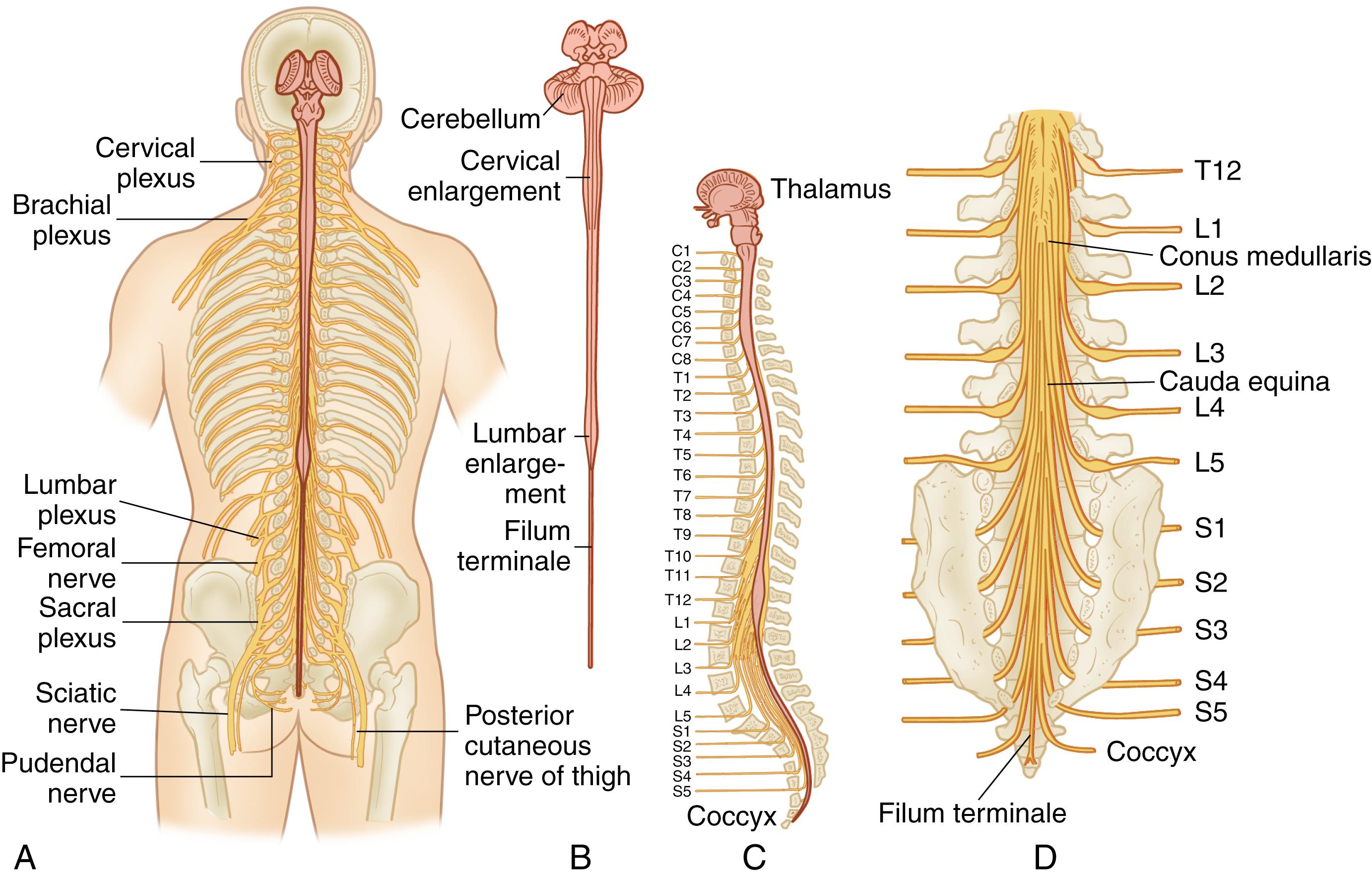
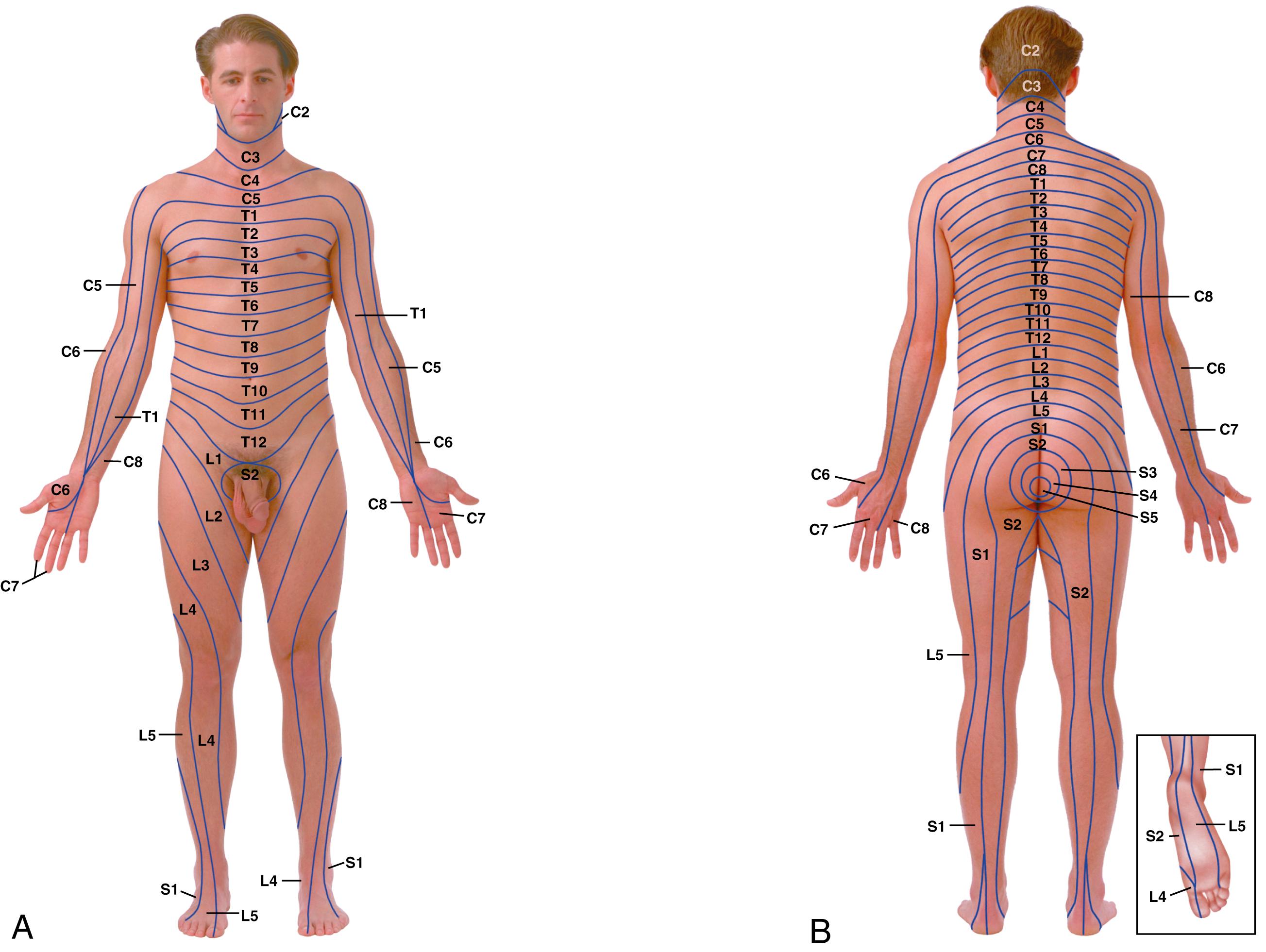
Within the spinal cord, each spinal nerve separates into anterior and posterior roots. The motor or efferent fibers of the anterior root carry impulses from the spinal cord to the muscles and glands of the body. The sensory or afferent fibers of the posterior root carry impulses from sensory receptors of the body to the spinal cord and then on to the brain for interpretation by the cerebral sensory cortex.
A spinal afferent (sensory) neuron may initiate a reflex arc response when it receives an impulse stimulus such as a tap on a stretched muscle tendon. In this case, the response is transmitted outward by the efferent (motor) neuron in the anterior horn of the spinal cord via the spinal nerve and peripheral nerve of the skeletal muscle, stimulating a brisk contraction ( Fig. 23.7 ). Such a reflex is dependent on intact afferent neurons, functional synapses in the spinal cord, intact efferent neurons, functional neuromuscular junctions, and competent muscle fibers.
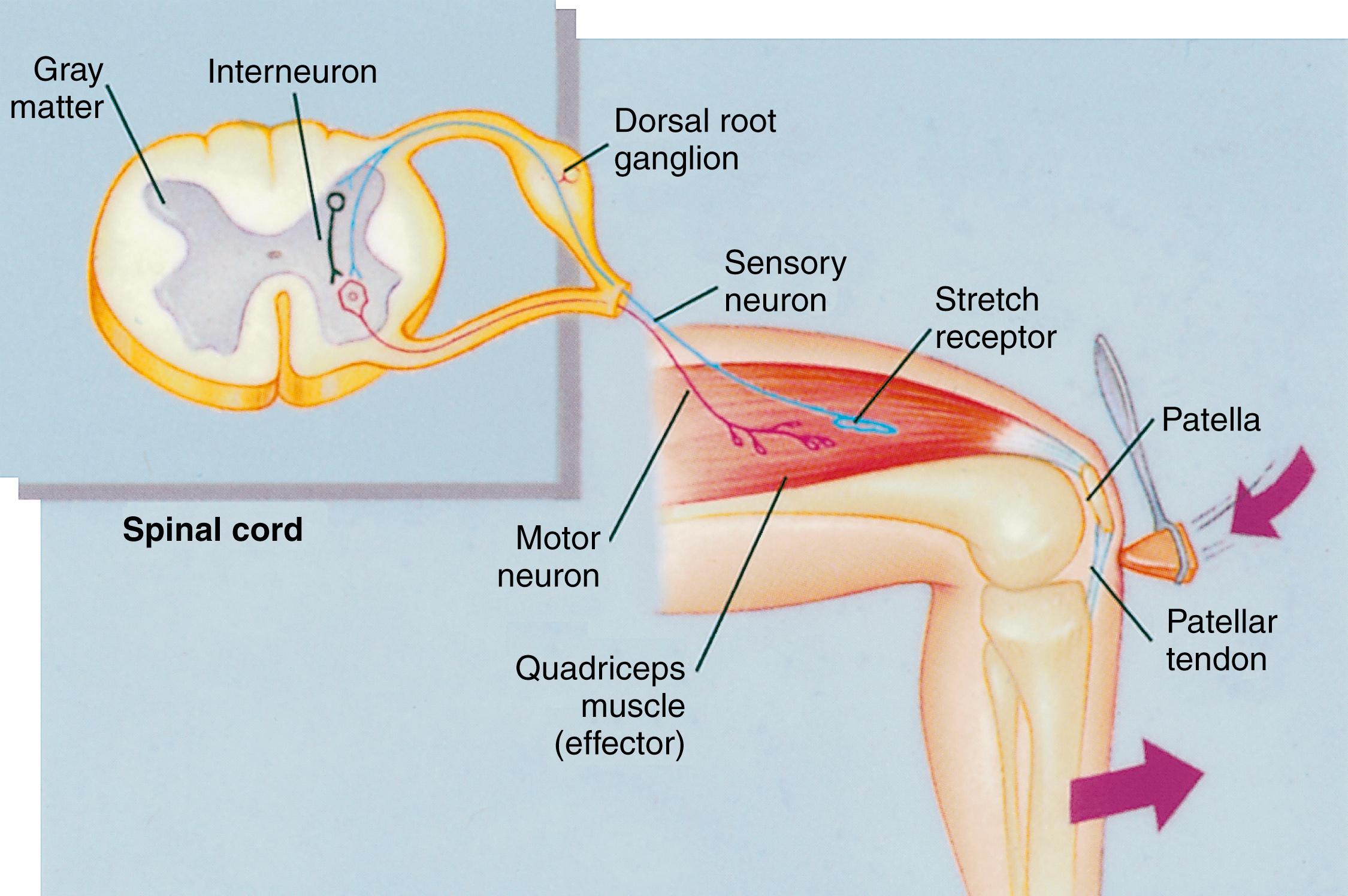
The major portion of brain growth occurs in the first year of life, along with myelinization of the brain and nervous system. Any event that disrupts brain development and growth during this period (e.g., infection, poor nutrition, or trauma) can have profound effects on eventual brain function. At birth, the neurologic impulses are primarily handled by the brainstem and spinal cord, such as the following reflexes: sucking, rooting, yawning, sneezing, hiccupping, blinking at bright light, and withdrawing from painful stimuli. Some common newborn reflexes are present at birth (e.g., Moro, stepping, palmar and plantar grasp), and as the brain develops, these reflexes are inhibited as more advanced cortical functions and voluntary control take over.
Motor maturation proceeds in a cephalocaudal direction. Motor control of the head and neck develops first, followed by the trunk and extremities. Motor development progresses, enabling more complex and independent functioning (see the table “Expected Motor Development Sequence in Children” in Chapter 22 ). Development occurs in an orderly sequence, but the timing varies considerably among children. Many capabilities may develop simultaneously in a child.
Hypothalamic-pituitary neurohormonal changes occur with pregnancy; however, specific alterations in the neurologic system are not well identified. During the first trimester, individuals have increased sleep needs, but they may not feel rested, even with increased sleep. Late in pregnancy, sleep can be affected due to multiple discomforts, such as back pain, frequent urination, leg cramps, and restless leg syndrome.
The number of cerebral neurons decreases with aging, along with decreased brain size. The vast number of reserve neurons inhibits the appearance of clinical signs in many cases. Sensory functions such as taste, smell, and vision may be diminished. The velocity of nerve impulse conduction declines, so responses to various stimuli may be diminished, such as deep tendon reflexes. Sleep disturbances also occur. See Chapter 7 for changes in mental functioning.
For each of the symptoms or conditions discussed in this section, particular topics to include in the history of the present illness are listed. Responses to questions about these topics provide clues for individualizing the physical examination and the development of a diagnostic evaluation appropriate for the particular patient. Questions regarding medication use (prescription and over-the-counter preparations) as well as complementary therapies are relevant for each area.
Independent observer’s report: fall to ground, shrill cry, motor activity, transition phase, change in color of face or lips, pupil changes or eye deviations, loss of consciousness, loss of bowel or bladder control
Aura (perceptual sensation that may signal a seizure): irritability, tension, confusion, blurred vision, mood changes, initial focal motor seizure activity, gastrointestinal distress
Level of consciousness: loss, impairment, duration
Automatism: eyelid fluttering, chewing, lip smacking, swallowing
Muscle tone: flaccid, stiff, tense, twitching; where spasm began and moved through the body; change in character of motor activity during seizure
Postictal phase: weakness, transient paralysis, confusion, drowsiness, headaches, muscle aching, sleeping after seizure; any lateralization of signs
Relationship of seizure to time of day, meals, fatigue, emotional stress, excitement, menses, and discontinuing medications or poor medication adherence; activity before episode
Frequency of seizures; total length of seizure activity; age at first seizure
Medications: antiepileptic; initiation of medication or complementary or alternative therapy, potential for herb or product use that interacts with prescribed antiepileptic medication
See Chapter 6 for general pain assessment but consider “neurologic-specific” pain such as headaches associated with meningitis or encephalitis, space-occupying lesions, neck pain, sciatica, trigeminal neuralgia, or diabetic neuropathy.
Onset: sudden or progressive, associated with fever or injury
Quality and intensity: deep or superficial; aching, boring, throbbing, sharp or stabbing, burning, pressing, stinging, cramping, gnawing, prickling, shooting; duration and constancy
Location or path: along distribution of one or more peripheral nerves, the feet, or a more general distribution; radiating from one part to another
Associated manifestations: crying, change in activity or energy level, sweating, muscle rigidity, tremor, impaired mental processes or concentration, weakness
Efforts to treat and impact on life
Medications: opioids or nonsteroidal anti-inflammatory drugs; prescription, nonprescription
Balance: sensation of leaning when walking to doorway; unsteadiness when walking
Vertigo: see Chapter 13 , “History of Present Illness,” for more information
Falling: fall in consistent direction, backward, forward; associated with looking up; legs simply giving way; stiffness of limbs
Associated problems: arthritis of cervical spine or knees, ataxia, stroke, seizure, arrhythmias, sensory changes
Medications: phenytoin, pyrimethamine, etoposide, vinblastine; prescription, nonprescription
Onset: sudden, with activity initiation or following sustained activity, time before symptoms begin; rapid or slow
Character: generalized or specific body area affected (face, extremity); progressively ascending or transient; proximal or distal extremities, unilateral, bilateral, or asymmetric; difficulty walking; loss of balance or coordination; hypersensitivity to touch or burning sensation
Associated symptoms: tingling or numbness; confusion, trouble speaking or understanding speech; severe headache; impaired vision in one or both eyes; limb feels encased in tight bandage, pain, shortness of breath, stiffness of joints, spasms, muscle tension, sensory deficits; loss of urinary or bowel control; personality change
Concurrent chronic illness such as human immunodeficiency virus (HIV) infection, diabetes, nutritional or vitamin deficiency, or recent acute illness
Medications: zidovudine, chemotherapy, HIV medications, amphotericin B
Hypertension
Obesity
Sedentary lifestyle
Smoking tobacco products
Stress
Increased levels of serum cholesterol, lipoproteins, and triglycerides
Use of oral contraceptives
Sickle cell disease
Family history of diabetes mellitus, cardiovascular disease, hypertension, and increased serum cholesterol levels
Congenital cerebrovascular anomalies
Onset: sudden or gradual
Character: worse with rest, intentional movement, or anxiety; unilateral or bilateral; body location (distal extremities, head); interference with daily activities and impact on life
Associated problems: hyperthyroidism, familial tremor, liver or kidney disorder, consumption of alcohol, multiple sclerosis (MS)
Relieved by: rest, activity, alcohol
Medications: neuroleptics, valproate, phenytoin, albuterol, pseudoephedrine, antiarrhythmics, corticosteroids, caffeine (all may cause essential tremor)
Trauma: concussion or brain injury, spinal cord injury, or localized injury; CNS insult; birth trauma; stroke
Meningitis, encephalitis, lead poisoning, poliomyelitis
Congenital anomalies, genetic syndromes
Cardiovascular, circulatory problems: hypertension, aneurysm, peripheral vascular disease
Neurologic disorder, brain surgery, residual effects
Headaches (e.g., migraines)
Hereditary disorders: neurofibromatosis, Huntington chorea, muscular dystrophy, diabetes, pernicious anemia
Alcoholism
Intellectual disability
Epilepsy or seizure disorder, headaches
Alzheimer disease or other dementia, Parkinson disease
Learning disorders
Weakness or gait disorders, cerebral palsy (CP)
Medical or metabolic disorder: thyroid disease, hypertension, diabetes mellitus
Environmental or occupational hazards: exposure to lead, arsenic, insecticides, organic solvents, other chemicals; operate or live on farm, handle dangerous equipment or work at heights or in water (neurologic disorder may impact employment or personal safety)
Hand, eye, and foot dominance; family patterns of dexterity and dominance
Ability to care for self: hygiene, activities of daily living, finances, communication, shopping; ability to fulfill work expectations
Sleeping or eating patterns; weight loss or gain; anxiety
Use of alcohol or illicit drugs, especially mood-altering drugs
Prenatal history: pregnant person’s health, medications taken, intrauterine infections such as toxoplasmosis, zika, syphilis, tuberculosis, rubella, cytomegalovirus, herpes, fetal movement, prior history of hypertension, preeclampsia, bleeding, history of trauma or stress, malnutrition, persistent vomiting, hypertension, drug or alcohol use
Birth history: Apgar score, gestational age, prematurity, birth weight, presentation, use of instruments to assist in delivery, prolonged or precipitate labor, fetal distress
Respiratory status at birth: resuscitation needed, apnea, cyanosis, need for oxygen or mechanical ventilation
Neonatal health: jaundice (from ABO blood type incompatibility, breast-feeding, or other causes), perinatal infections, seizures, irritability, poorly coordinated suck and swallow, need for intensive care, ototoxic medication exposure
Congenital anomalies, congenital heart disease, or other physical disabilities
Hypotonia or hypertonia in infancy, developmental delay
Developmental milestones
Age attained: smiling, head control in prone position, grasping, transferring objects between hands, rolling over, sitting, crawling, independent walking, toilet-trained, saying words other than “mama” and “dada”
Pattern of development: similar to other children; always slower than others; loss of previously achieved function; change in the child’s rate of development; (progress occurred as expected until a certain age with slow progress afterward or regression)
Performance of self-care activities: dressing, toileting, feeding
Hyperactive or impulsive behavior; problems with schedule changes, sitting for entire meal; poor organizational skills, unable to handle more than one instruction at a time, uncontrolled anger, poor social skills; school problems
Health problems:
Headaches, unexplained vomiting, lethargy, personality changes
Seizure activity: association with fever, frequency, duration, character of movement
Any clumsiness, unsteady gait, progressive muscular weakness, unexplained falling, problems going up and down stairs, problems getting up after lying down on floor
Weeks of gestation or estimated date of delivery
Seizure activity: past history of seizures or pregnancy-induced hypertension; frequency, duration, character of movement
Headache: onset, character, frequency, association with hypertension; visual changes
Nutritional status: dietary supplements such as prenatal vitamins, calcium; salt depletion
Pattern of increased stumbling, falls, unsteadiness, or decreased agility; worse in the dark; safety modifications used in home
Interference with performance of daily living tasks, social withdrawal, personality change, feelings about symptoms
Hearing loss, vision deficit, anosmia—transient or persistent
Urinary or fecal incontinence
Transient neurologic deficits (may indicate transient ischemic attacks)
Ask these three screening questions to assess fall risk:
Have you fallen in the past year?
Do you feel unsteady when standing or walking?
Do you worry about falling?
A positive answer to any of the questions indicates a need for further assessment because fall risk is higher ( Centers for Disease Control and Prevention, 2016 b). Other risk factors for falls include the following:
Past history of a stroke
Neurologic condition such as Parkinson disease, dementia, or peripheral neuropathy
Disorder of gait, balance, or vertigo
Lower extremity weakness or sensory loss
Impaired vision
Use of an assistive device (e.g., walker or cane)
Penlight
Tongue blade, paper clip, cotton-tipped applicator
Tuning forks, 200 to 400 Hz and 500 to 1000 Hz
Familiar objects: coins, keys, paper clip
Cotton wisp
5.07 monofilament
Reflex hammer
Additional items for a comprehensive diagnostic neurologic examination
Vials of aromatic substances: coffee, orange, peppermint extract, oil of cloves
Vials of solutions: glucose, salt, lemon or vinegar, and quinine—with applicators for taste testing
Test tubes of hot and cold water for temperature sensation testing
Because the neurologic examination is complex, the discussion is divided into four sections for an organized approach. These sections include cranial nerves, proprioception and cerebellar function, sensory function, and reflex function. Assessment of mental status is detailed in Chapter 7 . Evaluation of muscle tone and strength, an integral part of the neurologic examination, is detailed in Chapter 22 .
The neurologic system is assessed during the entire visit. As you ask the patient entering the room to sit, you gain information about the neurologic system. You can observe balance, coordination and smoothness of gait, and ability to follow directions, and the ability to sit and stand. The musculoskeletal examination, particularly muscle tone and strength, provides important information about the neurologic examination because the systems are interdependent. When the history and examination findings have not yet revealed a potential neurologic problem, a neurologic screening examination may be performed ( Box 23.1 ).
The shorter screening examination is commonly used for health visits when no known neurologic problem is apparent.
Cranial nerves II through XII are routinely tested; however, taste is not tested unless some aberration is found.
One test is administered for each of the following: rapid rhythmic alternating movements, accuracy of movements, balance (Romberg test is given), and gait and heel-toe walking.
Superficial pain and touch at a distal point in each extremity are tested; vibration and position senses are assessed by testing the great toe.
All deep tendon reflexes are tested, excluding the plantar reflex and the test for clonus.
Evaluating the cranial nerves is an integral part of the neurologic examination. Ordinarily, taste and smell are not evaluated unless a problem is suspected. A patient may not recognize that some hearing, certain taste sensations, or some vision has been lost. When a sensory loss is suspected, be compulsive about determining the extent of loss when testing the relevant cranial nerve.
Examination of some cranial nerves is described in detail in other chapters, associated with the body system in which they are most commonly evaluated. Testing of the optic (II), oculomotor (III), trochlear (IV), and abducens (VI) nerves are described in Chapter 12 ; the acoustic (VIII) and hypoglossal (XII) nerves in Chapter 13 ; and the spinal accessory nerve (XI) in Chapter 22 . Table 23.3 describes a review of all cranial nerve examination procedures. Unexpected findings (focal deficits) indicate trauma or a lesion in the cerebral hemisphere or local injury to the nerve. See Clinical Pearl, “Mnemonic for Cranial Nerve Names.”
One way to remember the cranial nerves is the mnemonic for the first letter of each nerve: On Old Olympus Towering Tops A Finn and German Viewed Some Hops. Classification of each cranial nerve by function—Sensory (S), Motor (M), or Both (B) can be remembered by the mnemonic: Some Say Marry Money But My Brother Says Bad Business Marry Money.
| Cranial Nerve (CN) | Procedure |
|---|---|
| CN I (olfactory) | Test ability to identify familiar aromatic odors, one naris at a time with eyes closed. |
| CN II (optic) | Test distant and near vision. Perform ophthalmoscopic examination of fundi. Test visual fields by confrontation and extinction of vision. |
| CN III (oculomotor), CN IV (trochlear), and CN VI (abducens) | Inspect eyelids for drooping. Inspect pupils’ size for equality and their direct and consensual response to light and accommodation. Test extraocular eye movements. |
| CN V (trigeminal) | Inspect face for muscle atrophy and tremors. Palpate jaw muscles for tone and strength when patient clenches teeth. Test superficial pain and touch sensation in each branch (test temperature sensation if there are unexpected findings to pain or touch). Test corneal reflex. |
| CN VII (facial) | Inspect symmetry of facial features with various expressions (e.g., smile, frown, puffed cheeks, wrinkled forehead). Test ability to identify sweet and salty tastes on each side of tongue. |
| CN VIII (acoustic) | Test sense of hearing with whisper screening tests or by audiometry. Compare bone and air conduction of sound. Test for lateralization of sound. |
| CN IX (glossopharyngeal), and X (vagus) | Test ability to identify sour and bitter tastes on each side of tongue. Test gag reflex and ability to swallow. Inspect palate and uvula for symmetry with speech sounds and gag reflex. Observe for swallowing difficulty. Evaluate quality of guttural speech sounds (presence of nasal or hoarse quality to voice). |
| CN XI (spinal accessory) | Test trapezius muscle strength (shrug shoulders against resistance). Test sternocleidomastoid muscle strength (turn head to each side against resistance). |
| CN XII (hypoglossal) | Inspect tongue in mouth and while protruded for symmetry, tremors, and atrophy. Inspect tongue movement toward nose and chin. Test tongue strength with index finger when tongue is pressed against cheek. Evaluate quality of lingual speech sounds (l, t, d, n). |
The olfactory nerve is tested when a concern exists with the patient’s ability to discriminate odors. Have available two or three vials of familiar aromatic odors. Use the least irritating aromatic substance (e.g., orange or peppermint extract) first so that the patient’s perception of weaker odors is not impaired. Before starting the assessment, make sure the patient’s nasal passages are patent. Occlude one naris at a time and ask the patient to breathe in and out.
Ask the patient to close his or her eyes and to occlude one naris. Hold an opened vial under the nose. Ask the patient to inspire deeply (so the odor reaches the upper nose and swirls around the olfactory mucosa) and to identify the odor ( Fig. 23.8 ). Use a different odor to test the other side. Continue the assessment, alternating between sides with two or three odors, comparing the patient’s ability to identify and discriminate between odors. Avoid offering multiple odors too quickly as this may confuse the olfactory sense.
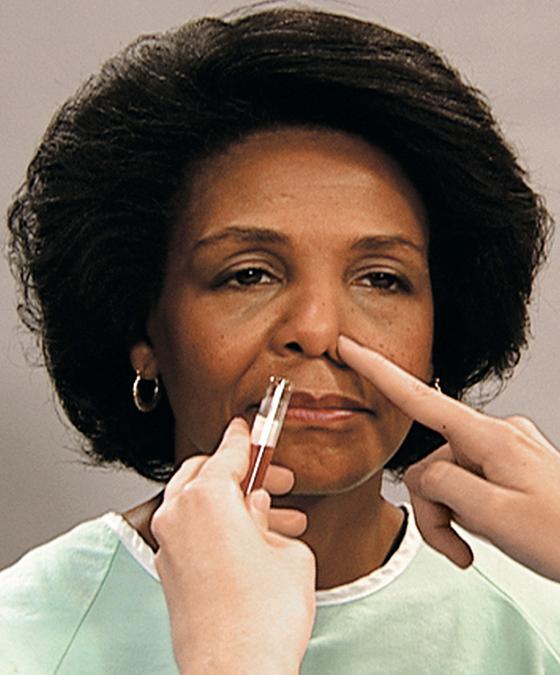
Patients are expected to perceive an odor on each side and usually to identify it. Inflammation of the mucous membranes, allergic rhinitis, and excessive tobacco smoking may all interfere with the ability to distinguish odors. The sense of smell may diminish with age. Anosmia, the loss of sense of smell or an inability to discriminate odors, can be caused by trauma to the cribriform plate, an olfactory tract lesion, or infection.
Visual acuity and visual fields are evaluated as described in Chapter 12 .
Movement of the eyes through the six cardinal points of gaze, pupil size, shape, response to light and accommodation, and opening of the upper eyelids is described in Chapter 12 .
When assessing patients with severe, unremitting headaches, the experienced examiner evaluates movement of the eyes for the presence or absence of lateral (temporal) gaze. The function of cranial nerve VI is often lost first in the presence of increased intracranial pressure.
Evaluate motor function by observing the face for muscle atrophy, deviation of the jaw to one side, and fasciculation (muscle twitches). Have the patient tightly clench the teeth as you palpate the muscles over the jaw, evaluating tone ( Fig. 23.9 ). Muscle tone over the face should be symmetric without fasciculation.
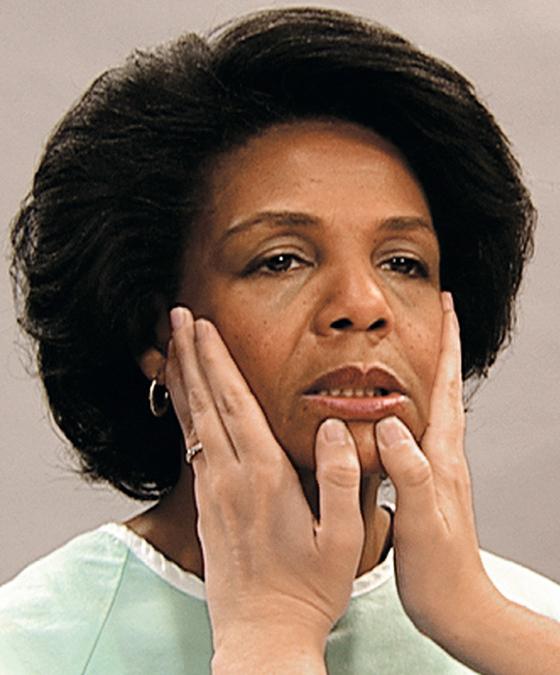
The three divisions of the trigeminal nerve are evaluated for sharp, dull, and light touch sensation ( Fig. 23.10 ). With the patient’s eyes closed, touch each side of the face at the scalp, cheek, and chin areas, alternately using the sharp and smooth edges of a broken tongue blade or a paperclip. Avoid using a predictable pattern. Ask the patient to report whether each sensation is sharp or dull. Then stroke the face in the same six areas with a cotton wisp, brush, or lightly with a finger pad, asking the patient to tell when the stimulus is felt. A wooden applicator is used to test sensation over the buccal mucosa. Discrimination of all stimuli is expected over all areas of the face.
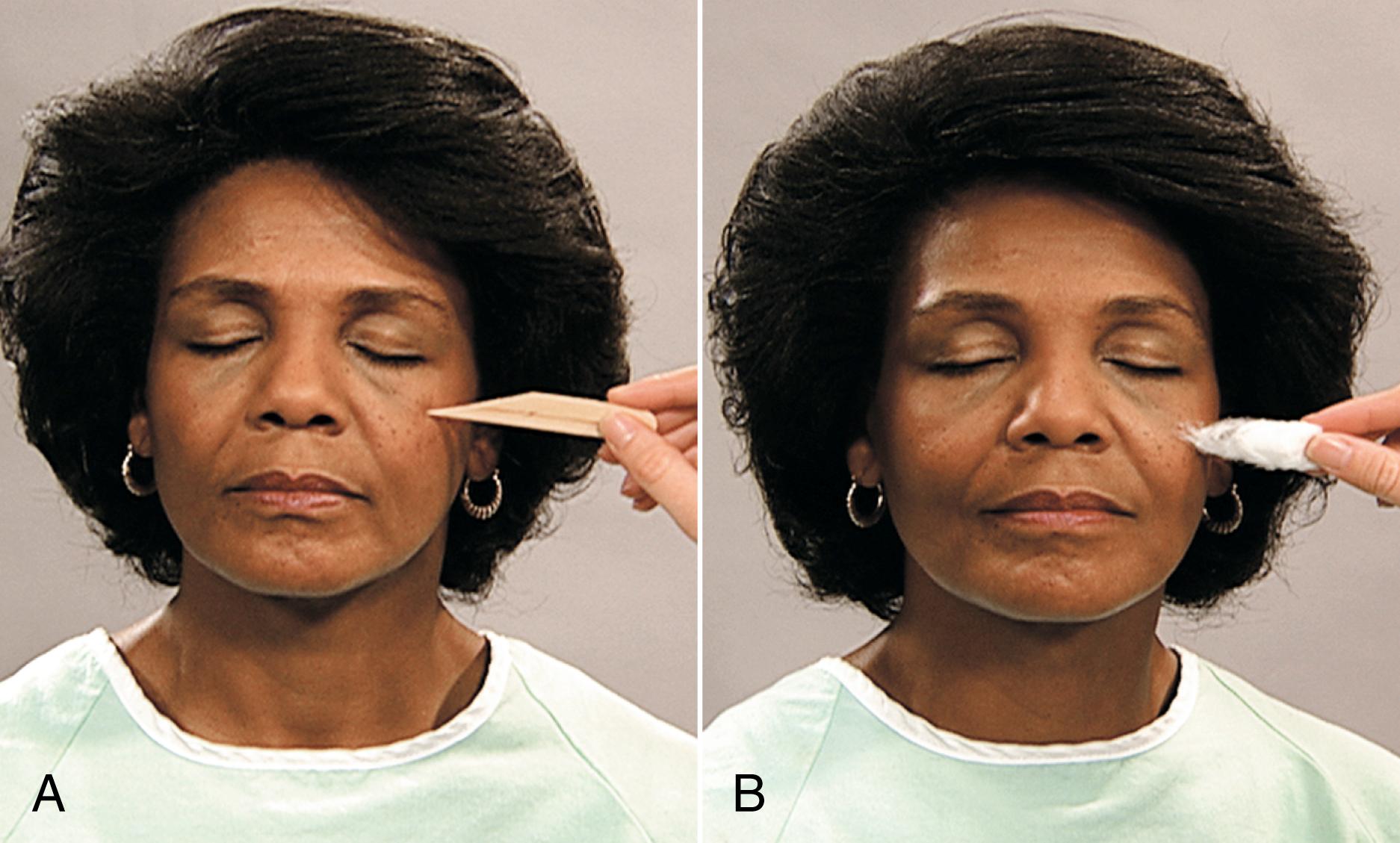
If sensation is impaired, use test tubes filled with hot and cold water to evaluate temperature sensation. Ask the patient to tell you if the tubes feel hot or cold as you touch the same six areas of the face. Contrast the discrimination of temperature with the other sensations.
When assessment of the corneal reflex is clinically indicated, have the patient look up and away from you as you approach from the side (contact lenses, if used, should be removed). Avoiding the eyelashes and the conjunctiva, lightly touch the cornea of one eye with a cotton wisp. Repeat the procedure on the other cornea. A symmetric blink reflex to corneal stimulation is expected. Patients who wear contact lenses may have a diminished or absent reflex.
Evaluate motor function by observing facial expressions after asking the patient to raise the eyebrows, squeeze the eyes shut, wrinkle the forehead, frown, smile, show the teeth, purse the lips to whistle, and puff out the cheeks ( Fig. 23.11 ). Observe for tics, unusual facial movements, and asymmetry of expression. Listen as the patient speaks and note any difficulties with labial speech sounds (b, m, and p). Drooping of one side of the mouth, a flattened nasolabial fold, and a sagging lower eyelid are signs of muscle weakness. See the discussion of Bell palsy later in the chapter and Clinical Pearl, “Upper and Lower Neuron Disease.”
To distinguish between upper and lower neuron disease affecting the face, observe the patient’s face when he or she is laughing or crying. When the upper motor neurons are affected, as in a stroke or brain attack, voluntary movements are paralyzed, but emotional movements are spared. In a lower motor neuron disorder, such as Bell palsy, all facial movements on the affected side are paralyzed.
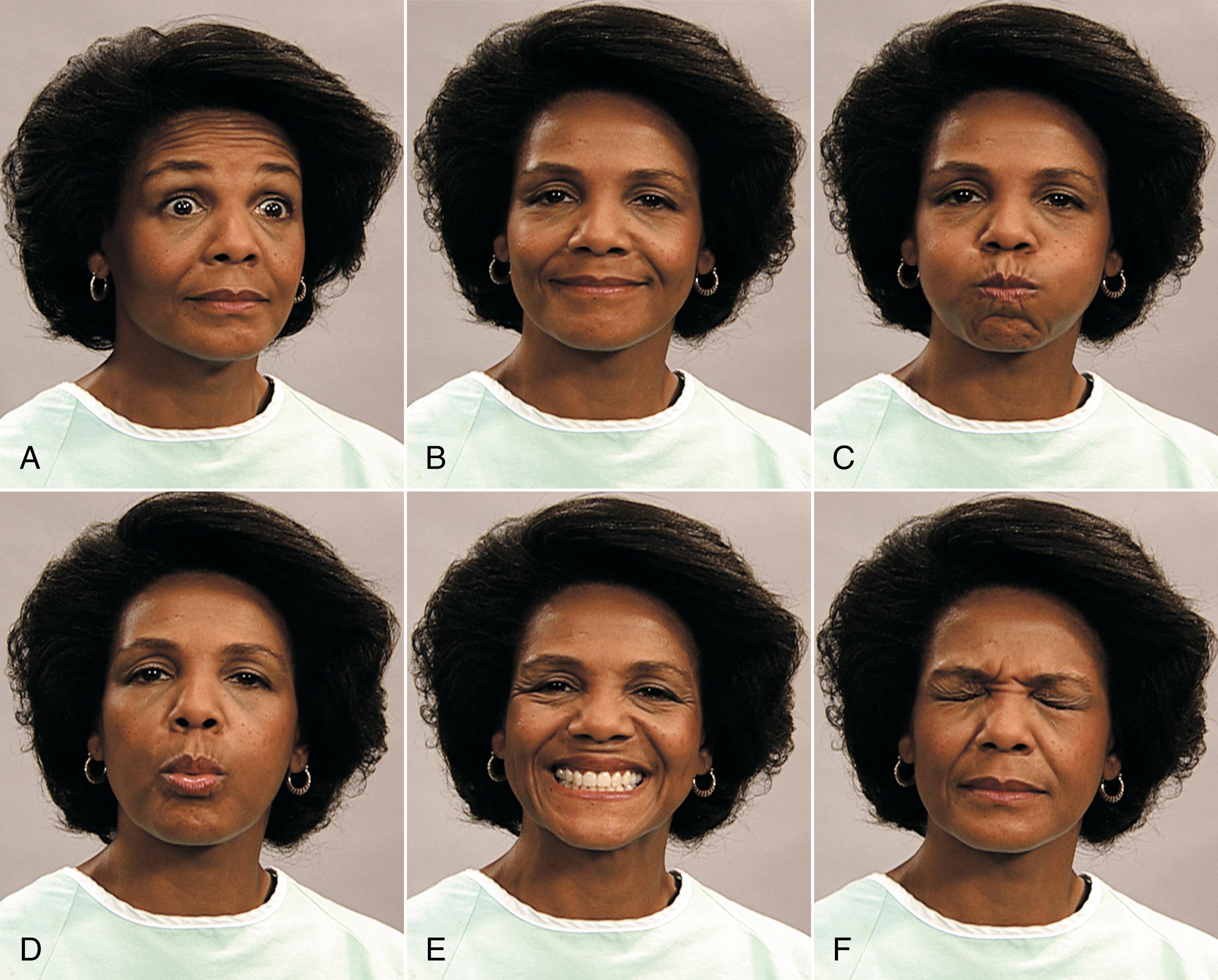
To evaluate taste, a sensory function of cranial nerves VII and IX, have available the four solutions, applicators, and a card listing the tastes (bitter, sour, salty, sweet). The fifth taste, umani (savory or meaty flavor) is less commonly tested. Make sure the patient cannot see the labels on the vials. Ask the patient to keep the tongue protruded and to point out the taste perceived on the card. Apply one solution at a time to the lateral side of the tongue in the appropriate taste bud region ( Fig. 23.12 ). Alternate the solutions, using a different applicator for each. Offer a sip of water after each stimulus. Each solution is used on both sides of the tongue to identify taste discrimination. The patient should identify each taste bilaterally when placed correctly on the tongue surface. Disorders of taste sensation may be related to loss of smell, traumatic brain injury, cancer therapy radiation, and prescription medications.
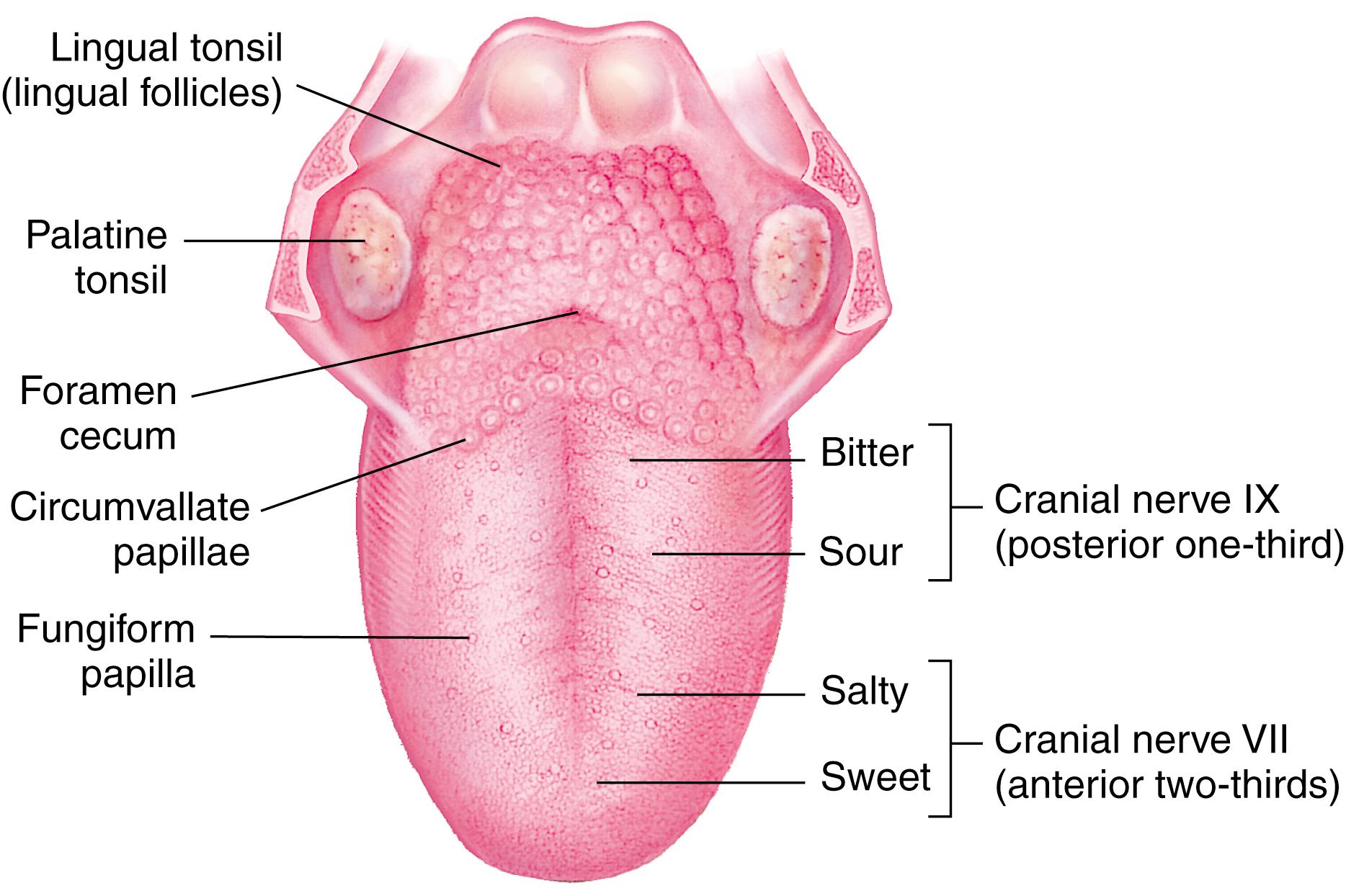
Become a Clinical Tree membership for Full access and enjoy Unlimited articles
If you are a member. Log in here